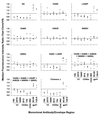A global neutralization resistance phenotype of human immunodeficiency virus type 1 is determined by distinct mechanisms mediating enhanced infectivity and conformational change of the envelope complex
- PMID: 10756031
- PMCID: PMC111933
- DOI: 10.1128/jvi.74.9.4183-4191.2000
A global neutralization resistance phenotype of human immunodeficiency virus type 1 is determined by distinct mechanisms mediating enhanced infectivity and conformational change of the envelope complex
Abstract
We have described previously genetic characterization of neutralization-resistant, high-infectivity, and neutralization-sensitive, low-infectivity mutants of human immunodeficiency virus type 1 (HIV-1) MN envelope. The distinct phenotypes of these clones are attributable to six mutations affecting functional interactions between the gp120 C4-V5 regions and the gp41 leucine zipper. In the present study we examined mechanisms responsible for the phenotypic differences between these envelopes using neutralization and immunofluorescence assays (IFA). Most monoclonal antibodies (MAbs) tested against gp120 epitopes (V3, CD4 binding site, and CD4-induced) were 20 to 100 times more efficient at neutralizing pseudovirus expressing sensitive rather than resistant envelope. By IFA cells expressing neutralization sensitive envelope bound MAbs to gp120 epitopes more, but gp41 epitopes less, than neutralization-resistant envelope. This binding difference appeared to reflect conformational change, since it did not correlate with the level of protein expression or gp120-gp41 dissociation. This conformational change was mostly attributable to one mutation, L544P, which contributes to neutralization resistance but not to infectivity enhancement. The V420I mutation, which contributes a major effect to both high infectivity and neutralization resistance, had no apparent effect on conformation. Notably, a conformation-dependent V3 neutralization epitope remained sensitive to neutralization and accessible to binding by MAbs on neutralization-resistant HIV-1 envelope. Sensitivity to sCD4 did not distinguish the clones, suggesting that the phenotypes may be related to post-CD4-binding effects. The results demonstrate that neutralization resistance can be determined by distinguishable effects of mutations, which cause changes in envelope conformation and/or function(s) related to infectivity. A conformation-dependent V3 epitope may be an important target for neutralization of resistant strains of HIV-1.
Figures



Similar articles
-
Mutations in both gp120 and gp41 are responsible for the broad neutralization resistance of variant human immunodeficiency virus type 1 MN to antibodies directed at V3 and non-V3 epitopes.J Virol. 1998 Sep;72(9):7099-107. doi: 10.1128/JVI.72.9.7099-7107.1998. J Virol. 1998. PMID: 9696803 Free PMC article.
-
Binding of antibodies to virion-associated gp120 molecules of primary-like human immunodeficiency virus type 1 (HIV-1) isolates: effect on HIV-1 infection of macrophages and peripheral blood mononuclear cells.Virology. 1997 Mar 17;229(2):360-9. doi: 10.1006/viro.1997.8443. Virology. 1997. PMID: 9126249
-
Multiple interactions across the surface of the gp120 core structure determine the global neutralization resistance phenotype of human immunodeficiency virus type 1.J Virol. 2003 Jul;77(14):8061-71. doi: 10.1128/jvi.77.14.8061-8071.2003. J Virol. 2003. PMID: 12829845 Free PMC article.
-
Neutralising epitopes of simian immunodeficiency virus envelope glycoprotein.J Med Primatol. 1995 May;24(3):145-9. doi: 10.1111/j.1600-0684.1995.tb00160.x. J Med Primatol. 1995. PMID: 8751054 Review.
-
Neutralization of HIV-1: a paradox of humoral proportions.FASEB J. 1991 Jul;5(10):2437-55. doi: 10.1096/fasebj.5.10.1712328. FASEB J. 1991. PMID: 1712328 Review.
Cited by
-
Mutations in envelope gp120 can impact proteolytic processing of the gp160 precursor and thereby affect neutralization sensitivity of human immunodeficiency virus type 1 pseudoviruses.J Virol. 2007 Dec;81(23):13037-49. doi: 10.1128/JVI.01215-07. Epub 2007 Sep 12. J Virol. 2007. PMID: 17855534 Free PMC article.
-
Genetic subtypes, humoral immunity, and human immunodeficiency virus type 1 vaccine development.J Virol. 2001 Jul;75(13):5721-9. doi: 10.1128/JVI.75.13.5721-5729.2001. J Virol. 2001. PMID: 11390574 Free PMC article. Review. No abstract available.
-
The v3 loop is accessible on the surface of most human immunodeficiency virus type 1 primary isolates and serves as a neutralization epitope.J Virol. 2004 Mar;78(5):2394-404. doi: 10.1128/jvi.78.5.2394-2404.2004. J Virol. 2004. PMID: 14963135 Free PMC article.
-
Identification and characterization of a new cross-reactive human immunodeficiency virus type 1-neutralizing human monoclonal antibody.J Virol. 2004 Sep;78(17):9233-42. doi: 10.1128/JVI.78.17.9233-9242.2004. J Virol. 2004. PMID: 15308718 Free PMC article.
-
Feline immunodeficiency virus-infected cat sera associated with the development of broad neutralization resistance in vivo drive similar reversions in vitro.J Virol. 2001 Sep;75(18):8868-73. doi: 10.1128/jvi.75.18.8868-8873.2001. J Virol. 2001. PMID: 11507234 Free PMC article.
References
-
- Bagley J, Dillon P J, Rosen C, Robinson J, Sodroski J, Marasco W A. Structural characterization of broadly neutralizing human monoclonal antibodies against the CD4 binding site of HIV-1 gp120. Mol Immunol. 1994;31:1149–1160. - PubMed
-
- Bagwell B. A journey through flow cytometric immunofluorescence analyses: finding accurate and robust algorithms that estimate positive fraction distribution. Clin Immunol Newsl. 1996;16:33–37.
-
- Barbas C F, Crowe J E, Jr, Cababa D, Jones T M, Zebedee S L, Murphy B R, Chanock R M, Burton D R. Human monoclonal Fab fragments derived from a combinatorial library bind to respiratory syncytial virus F glycoprotein and neutralize infectivity. Proc Natl Acad Sci USA. 1992;89:10164–10168. - PMC - PubMed
-
- Boots L J, McKenna P M, Arnold B A, Keller P M, Gorny M K, Zolla-Pazner S, Robinson J E, Conley A J. Anti-human immunodeficiency virus type 1 human monoclonal antibodies that bind discontinuous epitopes in the viral glycoproteins can identify mimotopes from recombinant phage peptide display libraries. AIDS Res Hum Retrovir. 1997;13:1549–1559. - PubMed
-
- Buchacher A, Predl R, Strutzenberger K, Steinfellner W, Trkola A, Purtscher M, Gruber G, Tauer C, Steindl F, Jungbauer A. Generation of human monoclonal antibodies against HIV-1 proteins; electrofusion and Epstein-Barr virus transformation for peripheral blood lymphocyte immortalization. AIDS Res Hum Retrovir. 1994;10:359–369. - PubMed
Publication types
MeSH terms
Substances
Grants and funding
LinkOut - more resources
Full Text Sources
Other Literature Sources
Research Materials
Miscellaneous

